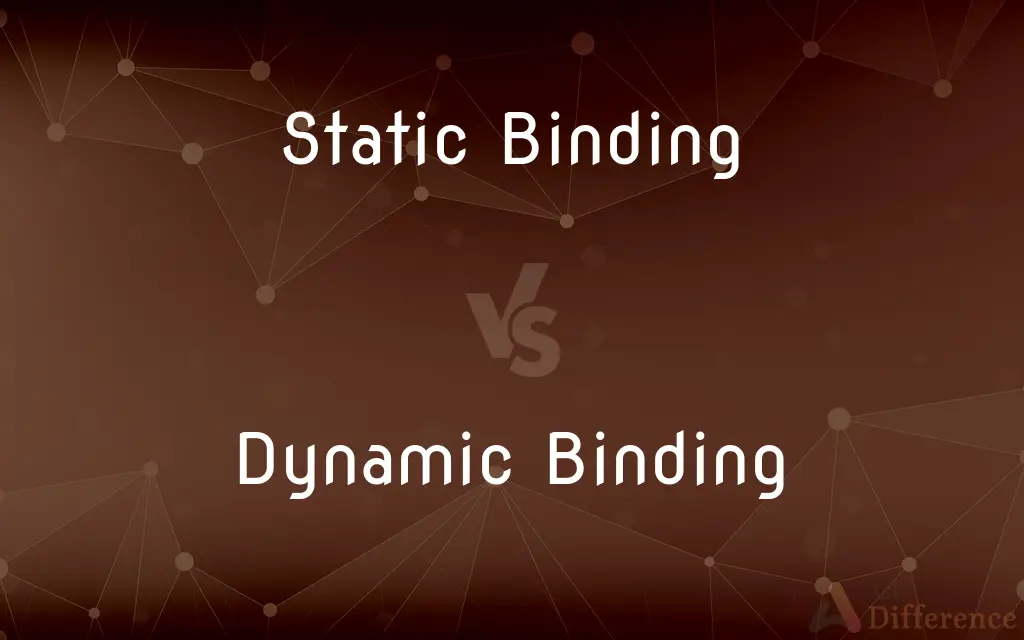Static Binding vs. Dynamic Binding — What's the Difference?
By Tayyaba Rehman — Published on December 13, 2023
Static Binding occurs at compile-time, using type information, while Dynamic Binding happens at runtime, based on an object's instance. Both affect method calls and variable access in object-oriented programming.

Difference Between Static Binding and Dynamic Binding
Table of Contents
ADVERTISEMENT
Key Differences
Static Binding, also known as early binding, happens at compile-time. This binding associates method calls with their definitions using type information. In contrast, Dynamic Binding, known as late binding, happens during runtime. It associates method calls based on the actual object instance rather than its type. In Static Binding, the method to execute is determined by the compiler, emphasizing the type of reference variable.
On the other hand, Dynamic Binding defers this decision to the runtime, basing it on the actual object the reference variable points to. The key distinction between Static Binding and Dynamic Binding lies in the phase of the program's life cycle when the binding occurs.
While Static Binding relies on static type information, making it more predictable, Dynamic Binding is more flexible, allowing for polymorphic behavior in object-oriented languages.
Comparison Chart
Timing
Compile-time
Runtime
Based On
Type of the reference variable
Actual object the reference points to
ADVERTISEMENT
Flexibility
Less flexible (decided at compile-time)
More flexible (allows polymorphism)
Performance
Generally faster (no overhead at runtime)
Might be slower (due to runtime decisions)
Example Language Feature
Method overloading in Java
Method overriding in Java
Compare with Definitions
Static Binding
Static Binding refers to compile-time binding.
In Java, method overloading uses Static Binding because the method call is determined at compile-time.
Dynamic Binding
Dynamic Binding determines method calls based on object instances.
Through Dynamic Binding, different subclass objects might invoke different method implementations.
Static Binding
Static Binding relies on the type information of variables.
Static Binding ensures that a particular method is invoked based on a variable's declared type.
Dynamic Binding
Dynamic Binding enables more flexible and adaptable code.
Dynamic Binding allows for versatile behavior, accommodating various object states.
Static Binding
Static Binding offers predictability in method calls.
With Static Binding, developers can anticipate method behavior during the coding phase.
Dynamic Binding
Dynamic Binding can introduce runtime overhead.
Because decisions are made at runtime with Dynamic Binding, there might be a slight performance cost.
Static Binding
Static Binding is a feature of many statically-typed languages.
In languages like Java, Static Binding plays a pivotal role in method resolution.
Dynamic Binding
Dynamic Binding occurs during runtime.
Polymorphism in object-oriented languages often relies on Dynamic Binding.
Static Binding
Static Binding minimizes runtime overhead.
Static Binding reduces the need for additional computations during program execution.
Dynamic Binding
Dynamic Binding often involves method overriding.
In Java, overridden methods utilize Dynamic Binding to decide which method to execute.
Common Curiosities
Is Static Binding generally faster or slower than Dynamic Binding?
Static Binding is generally faster as it lacks the runtime decision-making overhead.
What is Static Binding?
Static Binding, or early binding, occurs at compile-time using type information.
When does Dynamic Binding take place?
Dynamic Binding, or late binding, takes place at runtime based on an object's instance.
Which binding is more predictable?
Static Binding is more predictable since it's based on compile-time information.
Can Dynamic Binding introduce additional runtime costs?
Yes, Dynamic Binding might introduce a performance cost due to runtime decisions.
Which binding allows for polymorphic behavior?
Dynamic Binding allows for polymorphic behavior in object-oriented languages.
Is Static Binding limited to statically-typed languages?
While not exclusive, Static Binding is more commonly a feature of statically-typed languages.
Which binding uses type information?
Static Binding uses type information to make decisions.
How does Dynamic Binding determine which method to call?
Dynamic Binding uses the actual object instance to determine the method to call.
Is method overloading an example of Static or Dynamic Binding?
Method overloading is an example of Static Binding.
Which binding is associated with method overriding?
Method overriding is associated with Dynamic Binding.
Can Dynamic Binding enhance flexibility in code?
Yes, Dynamic Binding enhances code flexibility by accommodating different object behaviors.
Which binding type is decided at compile-time?
Static Binding is decided at compile-time.
Can Static Binding accommodate polymorphism?
Generally, polymorphism in object-oriented languages is better suited for Dynamic Binding.
Does Dynamic Binding rely on type information or actual objects?
Dynamic Binding relies on the actual objects the references point to.
Share Your Discovery

Previous Comparison
Oxygenic Photosynthesis vs. Anoxygenic Photosynthesis
Next Comparison
Annual Leave vs. Personal LeaveAuthor Spotlight
Written by
Tayyaba RehmanTayyaba Rehman is a distinguished writer, currently serving as a primary contributor to askdifference.com. As a researcher in semantics and etymology, Tayyaba's passion for the complexity of languages and their distinctions has found a perfect home on the platform. Tayyaba delves into the intricacies of language, distinguishing between commonly confused words and phrases, thereby providing clarity for readers worldwide.
















































